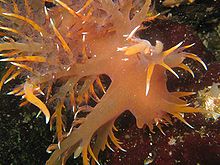- Dendronotus
-
Dendronotus 
Dendronotus iris Scientific classification Kingdom: Animalia Phylum: Mollusca Class: Gastropoda (unranked): clade Heterobranchia
clade Euthyneura
clade Nudipleura
clade Nudibranchia
clade Dexiarchia
clade Cladobranchia
clade DendronotidaSuperfamily: Tritonioidea Family: Dendronotidae Genus: Dendronotus Species: see text Dendronotus is a genus of sea slugs, nudibranchs, marine gastropod molluscs in the superfamily Tritonioidea.
This genus is within the clade Cladobranchia (according to the taxonomy of the Gastropoda by Bouchet & Rocroi, 2005).
Contents
Description
Dendronotus has an elongated, broad body, with 4 to 8 pairs of branched cerata on the notum. Animals in this genus have an obvious oral veil with 2 to 5 extensions. These extensions may be branched. Smaller unbranched extensions are found around the mouth. The rhinophores are surrounded by a sheath and the sheath itself has branched extensions. A large extension is found on the side at the base of each rhinophore. The anal opening occurs between the first and second set of dorsal cerata on the right side of the body[1].
Diet
This genus feeds on hydroids (anemones), as reflected by its serrated radula.[2][3]
Species
- Dendronotus albopunctatus Robilliard, 1972
- Dendronotus albus MacFarland, 1966
- Dendronotus dalli Bergh, 1879
- Dendronotus diversicolor Robilliard, 1972
- Dendronotus frondosus (Ascanius, 1774) (synonyms: D. arborescens, D. reynoldsi)
- Dendronotus iris J.G. Cooper, 1863 (synonym: D. giganteus)
- Dendronotus robustus Verrill, 1870 (synomym: D. velifer)
- Dendronotus rufus O'Donoghue, 1921
- Dendronotus subramosus MacFarland, 1966[4]
References
- ^ http://folk.ntnu.no/vmzotbak/nudibranchia/dendronotidae/dendronotidae.htm accessed 5 November 2009
- ^ W. J. Lambert (1991). "Coexistence of Hydroid Eating Nudibranchs: Do Feeding Biology and Habitat Use Matter?". The Biological Bulletin 181 (2): 248–260. doi:10.2307/1542096. http://www.biolbull.org/cgi/content/abstract/181/2/248.
- ^ Robilliard, G. A. (1972). "A new species of Dendronotus from the northeastern Pacific with notes on Dendronotus nanus and Dendronotus robustus (Mollusca: Opisthobranchia)". Canadian Journal of Zoology 50 (4): 421–432. doi:10.1139/z72-060.
- ^ http://www.catalogueoflife.org/browse_taxa.php?path=0,1,2,3,120,514,79076&selected_taxon=79076 accessed 5 November 2009
External links
- SEM images of its radula can be found at Thompson; Bebbington (1973). Malacologia 14: 147–165..
Categories:
Wikimedia Foundation. 2010.
